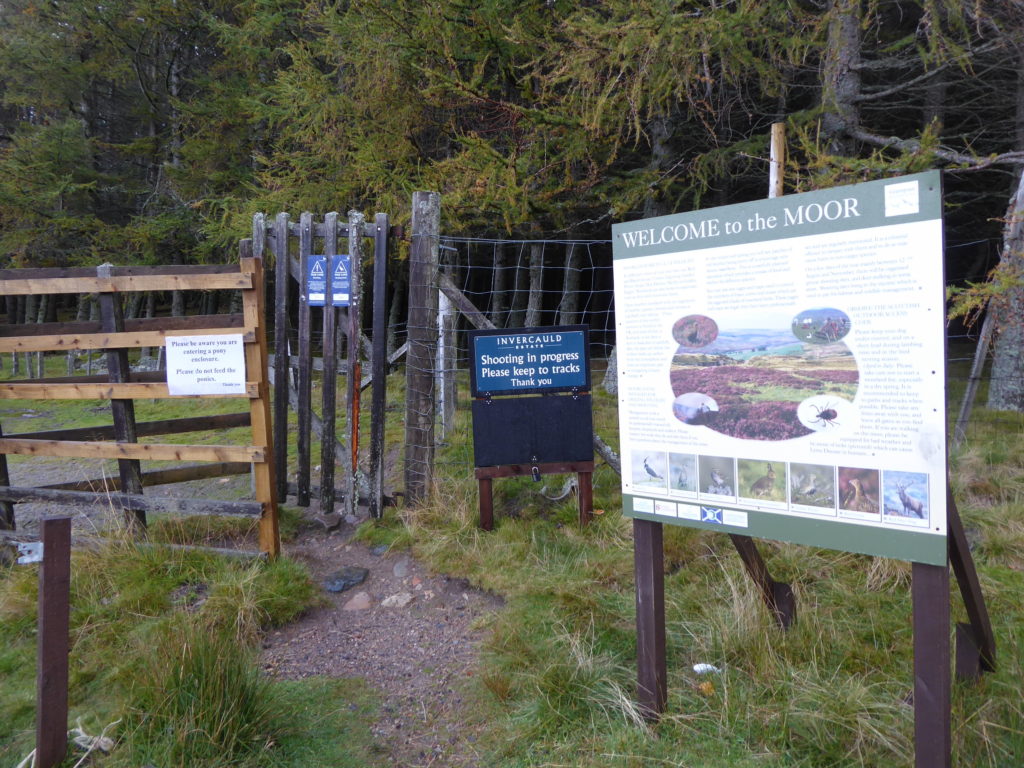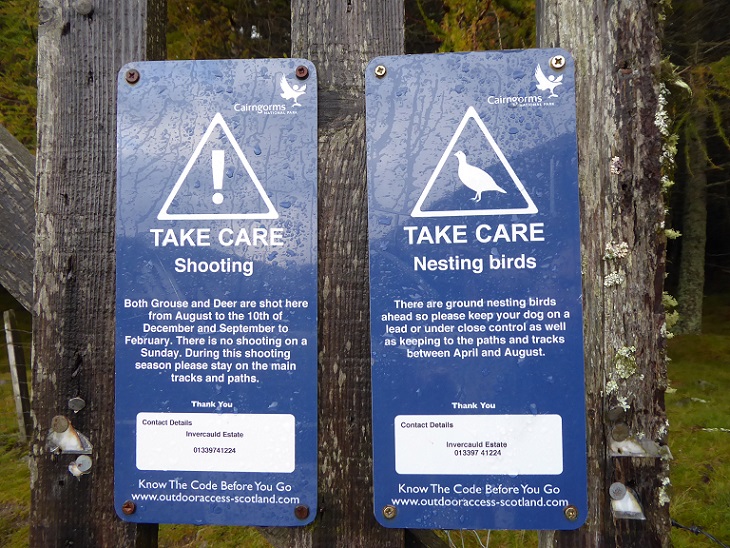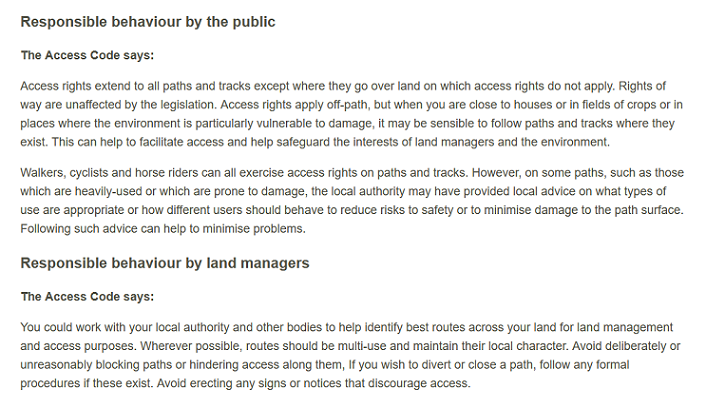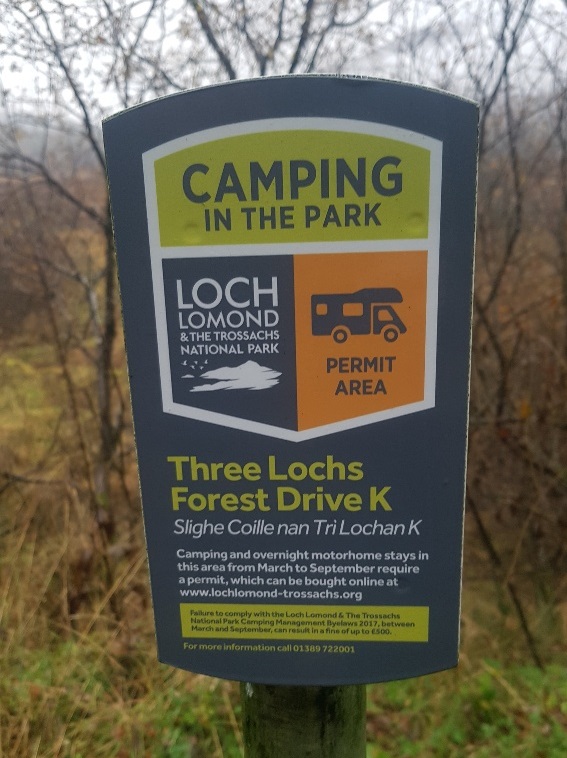
Signs in the countryside form part of the narrative about access and help shape public understanding about what the right to roam in Scotland means. Even if ignored by many, I find it hard to pass signs without taking a photo. Six weeks ago, on spotting a cluster of signs behind a Welcome to the Moor (see here for what is wrong with them) sign in Glen Clunie, I jumped out the car in the rain to take photos.

I had seen such signs before but it was only on reading them carefully afterwards that I realised the implications. While the Welcome to the Moor signs recommends that people should keep to paths and tracks “where possible”, these signs go further. They ask people, albeit politely, to keep to paths and tracks, full stop. In the case of the shooting sign, the advice to keep to the “main tracks and paths” is even more restrictive. Now consider the dates covered by this “advice”: from April to August you should keep to paths and tracks because of nesting birds; then from August to February you should keep on the main paths and tracks because of shooting. That, according to the Invercauld Estate, leaves the month of March when you are free to roam.
That advice from Invercauld, apparently endorsed by the Cairngorms National Park Authority, is incompatible what it says in the Scottish Outdoor Access Code (SOAC) (see here) about paths and tracks:

Effectively the SOAC advice says it may be sensible to follow paths and tracks close to buildings and fields, but says nothing about keeping to paths and tracks in open country like Glen Clunie. There is a reason for that, it would undermine the right to roam. So why are are Access Authorities allowing such signs to proliferate?
Inadequate resources
Part of the explanation is capacity. Last week the Scottish Outdoor Access Network (SOAN) issued a news release (see here) revealing that the number of access officers in Scotland had reduced from 65.5 full-time equivalents in 2005/6 to 36.5 FTE this year and that six access authorities don’t employ a single access officer. Between 2005 and 2016 the Scottish Government conducted annual monitoring of access officers (there were still 50 full-time equivalents in 2015-16). They then abandoned the surveys, a decision which has served to conceal the extent of the cuts. Despite all the failings in visitor infrastructure this summer, it was left to SOAN to conduct this year’s survey with support from Ramblers Scotland. All 34 access authorities – 32 councils plus our two national parks – responded, so the survey is comprehensive (see here for results).
The survey shows our National Parks and Highland Council, with three access officers each, are the only authorities that still have an access team, in any meaningful sense of that word. Highland Council used to have nine access staff and, had they been in a position to keep that resource, many of the issues associated with the North Coast 500 might have been addressed. Those access officers that remain tend to have a wide range of duties including policy development (e.g Outdoor Recreation Plans), path development, commenting on the access implications of planning applications and supporting Local Access Forums, where these still exist. Those duties may not leave much time to deal with bread and butter access issues, like locked gates and unlawful signs.
In the case of our two National Parks, however, which continue to be relatively well resourced, this is only part of the explanation for why misleading and unlawful signs are allowed to remain in place.
Inconsistencies in the ways our National Parks uphold access rights
In the last week the CNPA has informed me that the MacDonald Hotels have agreed to remove the no trespassers sign on the gate of their car park in Aviemore (see here). This follows agreement from Balmoral Estate to remove a sign there (see here). In both cases action has been taken quickly. Brilliant!
I have, however, got nowhere with getting the misleading advice to keep to the path on the Welcome to the Moor Signs removed. I suspect that is not just down to the Access Officers. I have heard through the grapevine that the Cairngorms National Park Authority may not actually have ever endorsed the signage, despite their logo appearing on it. For some reason they seem unwilling to act act. A possible explanation lies in the the power of the moorland landowners and the influence they have on the CNPA Board which includes, for example, Douglas McAdam, former Chief Executive of Scottish Land and Estates.

There are similar issues about fairness in applying the law as it affects access in the Loch Lomond and Trossachs National Park. Recently I was asked if this sign was legal? It threatens campervanners with a £500 fine for breaching the camping byelaws if they stop at Forest Drive without a permit.
The legal position is that under the camping byelaws there was an exception that allowed people to stop and spend the night in a vehicle in the new camping management zones where this was alongside a road where there was a public right of passage (see here for full explanation). Effectively, this made the byelaws unenforceable against campervans, particularly as the LLTNPA had no register showing over which roads there was a right of passage. The LLTNPA then more or less ceased trying to enforce them the byelaws against campervanners and abandoned its designation of certain laybys along the main roads (e.g on the north side of Loch Earn) as campervanning permit areas.
However, it continued to issue permits to campervans for three areas, Firkin Point and Inveruglas, which it owned, and Forest Drive, owned by Forest and Land Scotland. I did question this a couple of years ago but did not follow it through because, as long as facilities were provided, I believe it was reasonable for FLS and the LLTNPA to charge for those using those facilities overnight. What I did not realise, until I was sent this sign,was that the LLTNPA and FLS were still threatening to turn any campervanner who did not apply for a permit into a criminal. This is I believe a serious misuse of the law.
Technically, the LLTNPA could argue that at Forest Drive there is NO right of passage because FLS has long locked the gates there at night and therefore the byelaws can be applied to vehicles there. That may be true but if the LLTNPA wishes to apply the camping byelaws to vehicles that are parked away from roads where there is a vehicular right of passage, then to be fair and consistent it needs to apply those byelaws to every static campervan (also classed as a vehicle) and commercial campervan park in the camping management zones. The byelaws allow for this, but the LLTNPA would have to individually grant exemption for every static caravan or caravan site in the National Park. They have never done so.
There is also a specific question about Inveruglas, where the campervan permit area is located by what was the former A82. Anyone referred to the Procurator Fiscal for staying there without a permit would, I believe, have a strong legal case that this, like the other laybys along the A82, is part of the road network and therefore that the byelaws cannot be applied to vehicles staying there overnight.
The LLTNPA glossed over these issues in their three year report on the camping byelaws to Ministers earlier this year (see here – item six):
“2.5 Motorhomes and campervans
At the time of proposing the byelaws there was also a need to better manage some of the larger, off-road lochshore parking areas and areas of old road found in the National Park. Some of these sites, particularly along the A82 trunk road on West Loch Lomond and A85 by Loch Earn were experiencing
longer-term, seasonal encampments of larger vehicles and caravans (not as part of recognised Traveller communities) that had led to negative impacts on the local environment, visitor experience and nearby communities.
The initial introduction of motorhome and campervan permit areas on these stretches of roads in March 2017, was changed in June of that year following discussions with Police Scotland who proposed that that these issues would instead be managed under the Road Traffic Act 1988. Motorhome permit areas are still available under the National Park’s permit scheme (outlined in more detail in section 3.1) in certain areas of the National Park. These have been well used and received.”
Para 2.5 appears very carefully worded so the LLTNPA didn’t have to come clean about whether it was still threatening to criminalise any campervanner who failed to buy a permit in the remaining “permit areas”. I suspect that the Access Officers in the LLTNPA will be fully aware that that isn’t but have had their hands tied. Time to challenge the LLTNPA on the legality of these signs.
How do we put our rights to access the countryside onto a firmer footing?
What both the Welcome to the Moor and Campervanning signs show, in their very different ways, is that enforcement and protection of our rights to access the countryside don’t just depend on the capacity of access teams, however important that may be. It also depends on the willingness of senior managers and Board Members to uphold those rights and empower their staff to act. We therefore need individuals to keep reporting access issues, wherever they arise, and organisations like the Ramblers and Mountaineering Scotland, which represent outdoor recreationists, prepared to campaign to ensure that the law is rigorously and fairly applied.

The “Welcome to the Moor” signs with their recommendation “to keep to paths and tracks when possible” are unlawful. Nowhere in the 2003 land reform legislation or the Scottish Outdoor Access Code is there a requirement to keep to paths and tracks over extensive moorland areas. It is therefore reasonable to assume that estates which erect these signs have something to hide – why else would they erect signs that restrict public access unlawfully? Are these the estates where, in distant parts well away from public scrutiny, they are engaged in other unlawful activities, such as the persecution of golden eagles and hen harriers? When the licensing of grouse moors becomes a statutory requirement, at long last, will the estates with these “Welcome to the Moor” signs be the first to lose their licenses?
Those camping management sign are still there at laybys all along the north shore of Loch Earn and Loch Lomond side. How do we get them removed if they’re unenforceable ?
I thought the access legislation required all local authorities to have an access officer – the sting in the tail being that they weren’t required to fund or resource them to actually do anything.
Hi Niall, the legislation requires access authorities to uphold access rights but does not say how they should do this, so a Local Authority could, for example, give that responsibility to their roads department. The reason Scotland had access officers is that to help implement the legislation SNH funded specific posts to do this and they ended up being called Access Officers. The legislation contains a provision that Access Authorities MAY employ rangers “to advise and assist the owner of the land and other members of the public as to any matter relating to the exercise of access rights in respect of the land”. There is also a duty for every Access Authority to establish a Local Access Forum but NO duty on that LAF ever to meet…………………the legal framework was clearly not robust enough to ward off the impact of austerity and the survey found 8 LAFs have not met this year, extraordinary given the circumstances and the demand from people to get out in the countryside and open spaces. Nick
Thanks Nick, so if some LAs currently do not have officers that implies that the specific funding is no longer in place?
The minutes of my own LA’s LAF when it did meet show it was not particularly useful anyway. Locally we have one core path widened and surfaced at great expense to the sole benefit of cyclists, the rest are unmaintained so at this time of the year linear mires.
When a few years ago I managed by dint of great effort to extract a reply from an access officer to my letter identifying local problems and suggesting simple and low cost ways in which the local footpath network could be improved it was simply to say that if there was anything in my letter they were legally obliged to do it would be done.
What happened was that the grant funding originally provided by SNH was handed over to local authorities and not ring-fenced, so some local authorities then used it for other purposes. The relative amount of that funding has then been reduced by general cuts to Council services across the board.
Public funding should not be in the hands of an organisation naïve enough to fall into such a trap. There are serious deficiencies in any legislation which allows it to happen.
An interesting point about ground nesting birds is that they can still be nesting in August and even September. Does this mean that 50 plus beaters and shooters should not be trampling/driving across the moors and causing damage and disturbance at this time too?
The ease with which these restrictions slip into notices, recommendations etc does concern me. If you want to ask people to stick to the paths you have to have significant evidence that not doing so causes significant har. Quite apart from the fact that probably about 90% of walkers stick to the paths anyway, I do not recall any reliable evidence being presented that walkers at the kind of densities you enccounter on the open hill away from paths cause any damage to breeding rates etc. Re disturbance of deer stalking, I recall that when the National TRust took over MAr Lodge estate it trned out that , in that heavily used area by walkers, only 5% of stalks were distrubed in that way